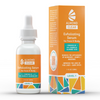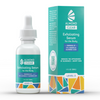Fungal Acne Skincare Routine
If you suffer from fungal acne, you know how finicky and sensitive this skin concern can be when it comes to skincare products. The hard part about having fungal acne is that most regular acne treatment products can make fungal acne even worse, so understanding what ingredients to avoid is super important. The good news: once you get a solid skincare routine down, fungal acne is actually fairly easy to keep at bay.
If you have no idea where to start when it comes to your fungal acne skincare routine, then look no further. In this blog post, we give an overview of the absolute essential steps to incorporate into your routine. ~ Hint hint ~ it’s only 4 steps! We’ll also provide fungal acne safe product options, as well as a list of common ingredients that feed on fungal acne and make it worse.
Ingredients to avoid

First, let’s go over what ingredients you should absolutely be avoiding if you have fungal acne:
-
Fatty acids and oils: Because fungi (AKA yeast) feeds on oils and fatty acids, these ingredients can cause fungal acne to grow and spread. Some examples: Laurice acid, Myristic acid, Tridecylic acid, Palmitic acid, Stearic acid, Oleic acid, and Linoleic acid
-
Esters: Esters are actually a combination of a fatty acid and an alcohol or glycerol. As we mentioned above, fatty acids are no good for fungal acne! Esters in skincare products usually end with ‘ate’, so look out for that on ingredient lists and you should be good to go. Some examples: isopropyl palmitate, decyl oleate, glyceryl stearate
-
Polysorbates: Another sneaky ingredient that feeds fungal acne to grow. To avoid polysorbates, look on the label for any ingredient with 'polysorbate' as part of its name. Some examples: Polysorbate-20, Polysorbate-40, Polysorbate-60, Polysorbate-80
-
Fatty Alcohols: Most fatty alcohols come from vegetable sources, such as coconut or palm oil, which clog pores and hair follicles, leading to more fungal acne. Some examples: lauryl, stearyl, and oleyl alcohols
-
Yeast Ferments: Fermented skin care means that microorganisms (bacteria) have been added. Adding extra bacteria and/or yeast to the skin should definitely be avoided if you have fungal acne. Some examples of fermented ingredients include: berries, seaweed, tea and yeast
- Coconut Oil: Coconut oil should be avoided for both fungal acne and regular acne sufferers because it’s highly comedogenic, meaning that it clogs pores. Besides that, it’s made up of 47% lauric acid, which is one of the main fatty acids you should always try to avoid.
For a comprehensive list of the ingredients to avoid, and all of the science behind why, check out Simple Skincare Science's blog post 1500+ Fungal Acne Safe Products.
If you want to check your current skincare products to see if they're fungal acne-safe, there are two great websites that do ingredients checks. They are sezia.co and Folliculitis Scout.
Skin Care Routine For Daily Use

Now, for the information you’ve been waiting for: your daily fungal acne skin care routine! On a daily basis, you should always keep it simple with these four steps: (1) cleanse, (2) treat, (3) moisturize and (4) SPF.
Step #1: Cleansing
Daily cleansing is important because it removes dirt, sweat, oil, and makeup off the surface of your skin, all of which feed fungal breakouts. It also refreshes your skin and gives it a chance to breathe.
Fungal acne safe cleansers:
- Almond Clear’s Face and Body Wash: This gel formula is powered by mandelic (almond) acid (MA) and therapeutic botanicals and is free from harmful additives. MA is strongly antibacterial and antifungal, so it clears up the microbes that cause folliculitis.
- Alba Botanica Acnedote Maximum Strength Deep Pore Wash: Made with a 2% salicylic acid and willow bark solution and is completely fungal acne safe. Salicylic acid helps to dissolve dead skin cells and oil that clog pores.
- Vanicream Gentle Facial Cleanser: This gentle cleanser is oil-free, non-comedogenic (non-pore-clogging), helps remove dirt, oil and makeup without drying the skin. It’s also free of dyes, fragrance, masking fragrance, lanolin, parabens, formaldehyde, formaldehyde releasers, and other preservatives. This is a great choice for very sensitive or dry skin.
Step #2: Leave-on Treatment
Applying a leave on acne treatment every day can clear up the microbes that cause folliculitis while also exfoliating dead skin cells and oil to unclog blocked hair follicles and pores. Leave-on acne treatment products come in a few different forms. Some of the most common are retinols, alpha hydroxy acids, beta hydroxy acids and vitamin C. Apply your leave on acne treatment to clean, dry skin and let dry for 60 to 90 seconds before moving on to the next step.
Fungal acne safe leave-on treatment products:
- Almond Clear Face & Body Clearing Serum: This serum contains 10% mandelic acid, which is the only alpha hydroxy acid that’s known for clearing up mild to moderate acne and folliculitis. It’s also a lot gentler on the skin than any other alpha hydroxy acid.
- Cos De BAHA Niacinamide 10 Serum: This niacinamide serum contains 10% vitamin B3, which means it’s packed with natural soothing properties that actively work to even your skin tone by addressing breakouts, blemishes, red marks and irritated skin.
- The Ordinary Niacinamide 10% + Zinc 1%: This leave on acne treatment visibly regulates sebum, minimizes pores and is completely fungal acne safe.
Step #3: Moisturizing

Moisturizing every single day is important because it reduces the chance of developing overly dry or oily skin, both of which can cause skin conditions like acne and fungal acne. We know, it’s easy to want to skip the moisturizer, especially if you have naturally oily skin, but don’t do it!!
We are so excited to announce that Almond Clear will be releasing a cream-based moisturizer that's folliculitis-safe in the fall of 2023. If you haven’t found the right moisturizer you can depend on yet, one of these fungal acne-safe options will definitely be your next go-to.
Fungal acne safe moisturizers:
- Almond Clear's Soothing Daily Moisturizer: This creamy, lightweight moisturizer is seriously hydrating and soothing. It quickly absorbs and leaves no heavy residue. It is safe for acne and folliculitis-prone skin and repairs the skin's protective barrier.
- Malezia 5% Urea Moisturizer: This moisturizer’s main ingredient is urea, a molecule found in the skin's natural moisturizing factor (NMF) that plays an integral role in improving skin barrier function. Urea has the ability to both hydrate and gently exfoliate the skin.
- Sebamed Clear Face Gel: Another moisturizer designed for acne-prone skin. Active moisturizing factors such as hyaluronic acid and natural aloe barbadensis give the skin plenty of moisture, while being completely fungal acne safe.
Step #4: Sunscreen
I know you’ve heard time and time again how important it is to wear sunscreen. But, sunscreen isn’t just there to prevent skin cancer and early signs of aging. It’s also super important to wear sunscreen every single day if you apply a leave-on acne treatment such as alpha hydroxy acids. This is because these acidic products make your skin much more sensitive to the sun and prone to sunburn. Additionally, if you have dark marks or acne scars from previous blemishes, sun exposure will only make them darker and more apparent. Bottom line: wear that SPF like there’s no tomorrow!
Fungal acne safe Sunscreens:
- Cotz the healthier Sunscreen: This is a mineral sunscreen that keeps your skin safe from harmful UVA-UVB rays. Great for fungal acne!
- EltaMD UV Clear Facial Sunscreen: This sunscreen is oil-free and recommended by dermatologists, as it helps calm and protect sensitive skin types prone to acne, rosacea and discoloration.
- La Roche-Posay Anthelios Mineral: A sensitive skin sunscreen with broad spectrum UVA/UVB protection SPF 50. Fast absorbing, none whitening, none greasy Zinc Oxide sunscreen. Suitable for use under makeup. Oxybenzone-free.
For weekly or ocassional use
These types of products aren’t essential to your skincare routine but can be applied occasionally if you feel like your skin needs a little extra TLC.
Face Masks

If you’re wanting a little extra boost to your fungal acne skincare routine, applying a face mask once or twice a week can help exfoliate the skin, unclog pores and brighten your complexion. Just be sure not to overdo it with the face masks because it can cause over-exfoliation.
Fungal acne safe face masks:
- Biossance Squalane Glycolic Renewal Facial: This face mask is powered by plant-derived squalane that gently exfoliates, refines and boosts radiance within the skin.
- Benton Aloe Soothing Mask: This tencel sheet is lightweight & close-fitting to nourish and hydrate the skin with a refreshing and comfortable feeling. This mask is slightly acidic and free of controversial ingredients such as fragrance, volatile alcohol and PEG.
Additional Treatment Products to Use Occasionally:
If you’re already using a leave-on acne treatment product but you’re still struggling with a more severe case of fungal acne, then adding a little bit of benzoyl peroxide or salicylic acid into your skincare routine a few times a week can give that extra oomph to clear the skin.
Benzoyl peroxide essentially performs the same function as a leave-on acne treatment by killing bacteria underneath the skin, as well as allowing the pores to shed dead skin cells and excess sebum (oil).
Salicylic acid is anti-inflammatory, anti-bacterial and prevents clogged pores, meaning it addresses all major causes of acne and fungal acne.
Salicylic acid is said to be more effective for blackheads and whiteheads, while benzoyl peroxide works well for pustules.
Fungal acne safe benzoyl peroxide & salicylic acid:
Shaving
Unfortunately, there aren’t many fungal acne safe shaving products out there. These products aren’t going to necessarily help clear fungal acne, but they do not feed fungal acne like many other shaving products do.
Fungal acne safe shaving products:
- Veet Legs & Body 3 in 1 Gel Cream Hair: Sensitive formula with Aloe Vera and Vitamin E to leave skin feeling moisturized. No leftover razor stubble or a danger of nicks and bumps.
- Fruit of the Earth Aloe Vera: Pure aloe vera gel to help calm and moisturize the skin during shaving.

Oils or Oil Cleansers
Oil cleansing is a way to gently remove makeup, soothe sensitive skin, and tame acne breakouts. Some people like using oils instead of traditional soaps or cleansers because they can help protect the natural lipid layer of the skin and the good bacteria that live there. Washing with an oil cleanser or applying a facial oil can lift excess sebum from the skin, clean out congested pores, and remove dead skin cells, dirt and makeup.
Fungal acne safe oils and oil cleansers:
- Kiss My Keto C8 MCT Oil: Powered by Caprylic Acid, this oil cleanser is completely fungal acne safe.
- The Ordinary 100% Plant-derived Squalane: Squalane is a saturated and stable hydrocarbon that delivers exceptional moisture retention properties and can help prevent transdermal moisture loss. Suitable for all skin types, it has been sustainably sourced and is non-comedogenic to avoid clogging pores.
The Bottom Line
Although fungal acne might be a little harder to treat than regular acne, once you understand what ingredients feed it, you'll be good to go. Remember to always keep your skincare routine simple, and once you find a product that works for you, stick to it!
Like what you read? Want to chat about skincare with people who have the same skin concerns as you? Join our Facebook Group- Almond Clear Skincare Support.








